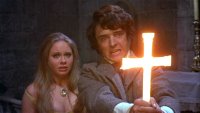Here's something interesting. The look of the latest complexity of Curves was reminiscent of a simple Histogram. So I tried it (because I don't know when to stop):
Curves Histogram


HISTOGRAM
RED Gamma 1.0 Midtones 0 = no adjustment
GREEN Gamma 0.9 Midtones 15
BLUE Gamma 0.8 Midtones 20
:)
edit:
ADDENDUM
I wanted to add this note to explain why the above part of this post was important (at least, to me) for the "de-fading" of film fade, which is not necessarily that same as "movie restoration". When motion picture film fades, it essentially loses contrast -- the picture as a whole becomes lighter as the film grain, which holds the darkness of colors, is bleached away. This happens in different degrees to the different color layers due to varied exposure to the environment that produces characteristic changes ("turning red").
For example, this faded 35mm film frame [center] from the 2001: A Space Odyssey trailer, when compared to the original picture [top] (a later "restored / remastered" DVD), demonstrates fade -- loss of contrast and spectrum shift at the color layer level:

Once these characteristics are identified, it is a procedurally simple matter to "re-contrast" the remaining color in the layers (there may be some unrecoverable loss of completely faded away highlights, but not as much as may appear at first examination) and "re-shift" their positions into a mostly corrected picture [bottom]. Histogram's functions (Low & High for contrast, Gamma for shifting, and Midtones for weighting the shift) are almost perfect to quickly and easily do this.
As gamma is only a close correction (it wasn't designed for film fading), the greater flexibility (and greater complexity) of Curves would be used for fine-tuning with "problem" corrections.
As is the case with the Song Of The South correction above, using Curves (and other such tools) is tricky. When one is too close to the color-trees, one loses sight of the picture-forest. Such micro-management results in squiggly-line adjustment curves, which is not how film fades nor is it the way to correct such fading. Applying manual smoothing reduces this +/- "ringing" of the adjustment. After my smoothing, I noticed the characteristic curves I see when using Histogram only. Going back to Histogram, I quickly adjusted it's functions to produce similar-looking curves and ... lo ... the mostly-same Curves-corrected picture appeared!
This is important as it indicates that the faded film (with normal fade variations, per reel) can be simply and globally corrected, with tweaks added thereafter where needed.
* As a side note, consider how luminance stabilization should be applied. Per R-G-B separation? To maximum values? Averages? To minimum values? Remember, it's not the luminance that is varying, but the degree of fade (the varying of contrast). As a practical matter, it may not make much difference, but tests should be conducted on a worst-case shot for that determination.












